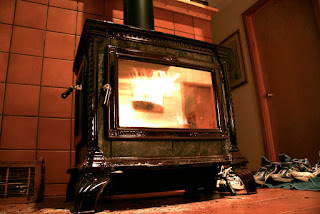How much do people use their woodburner?
One of the big science questions behind the CONA project is: How much do people use their woodburner?
Or perhaps, more precisely, does the amount they use their woodburner change much from day to day? Why? And is the variation predictable?
Another question we're interested in being able to answer is - if homes are supplied with new burning technology (maybe a new woodburner, or a catalyst, or different fuel) how can we measure if it has changed the amount they use their woodburner (and the amount of smoke their burner generates)?
Starting in mid June we began to send temperature sensors to 8 homes in Rangiora. We asked householders to fix one to their woodburner flue and one elsewhere in the living room. After 2 - 3 weeks we sent them some more and asked them to send the original ones back to us for analysis.
We have just completed our analysis of that original data for 5 of our homes and sent some results back to the householders. 2 to 3 weeks is not a lot of data for investigating behaviour, and 5 homes can hardly be considered a representative sample - but it's a start.
We calculated the number of hours of active burning for each day of the study. In fact, we found it made more sense to think of a 'day' as starting at 6am and finishing at 6am the next morning.
The average number of hours per day with active burning across our 5 homes ranged from 3.6 to 18.4 hours out of a maximum 24. We also re-analysed data from the same homes captured in August last year (September in one home). We found that woodburner use had increased in 4 out of 5 homes since last year. This may have been due to last year's data being collected towards the end of winter when outdoor temperatures had started to warm up .
Within each home, 4 out of 5 were quite consistent with very similar woodburner use from day to day. In the fifth home we observed a distinct increase in woodburner use as July progressed.
We will continue to collect this sort of data and extend this analysis throughout this winter. As the database grows we hope to start seeing some patterns in patterns of woodburner use, and especially how and when it changes as winter comes to an end. If more sensors can be distributed to homes in the future the more we will be able to understand and predict how many homes are likely to be using their woodburner (and emitting smoke into the atmosphere) at any given time on any given night.
Or perhaps, more precisely, does the amount they use their woodburner change much from day to day? Why? And is the variation predictable?
Another question we're interested in being able to answer is - if homes are supplied with new burning technology (maybe a new woodburner, or a catalyst, or different fuel) how can we measure if it has changed the amount they use their woodburner (and the amount of smoke their burner generates)?
Starting in mid June we began to send temperature sensors to 8 homes in Rangiora. We asked householders to fix one to their woodburner flue and one elsewhere in the living room. After 2 - 3 weeks we sent them some more and asked them to send the original ones back to us for analysis.
 |
| A temperature sensor on a woodburner |
We have just completed our analysis of that original data for 5 of our homes and sent some results back to the householders. 2 to 3 weeks is not a lot of data for investigating behaviour, and 5 homes can hardly be considered a representative sample - but it's a start.
We calculated the number of hours of active burning for each day of the study. In fact, we found it made more sense to think of a 'day' as starting at 6am and finishing at 6am the next morning.
The average number of hours per day with active burning across our 5 homes ranged from 3.6 to 18.4 hours out of a maximum 24. We also re-analysed data from the same homes captured in August last year (September in one home). We found that woodburner use had increased in 4 out of 5 homes since last year. This may have been due to last year's data being collected towards the end of winter when outdoor temperatures had started to warm up .
Within each home, 4 out of 5 were quite consistent with very similar woodburner use from day to day. In the fifth home we observed a distinct increase in woodburner use as July progressed.
 |
| Example data from one home - number of hours of woodburner use is fairly consistent but possibly reduced on warmer nights |

Comments
Post a Comment